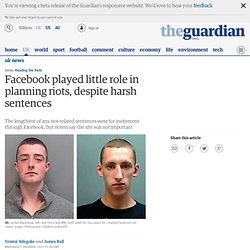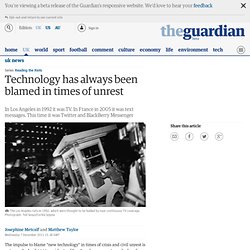

Facebook played little role in planning riots, despite harsh sentences. Facebook played little or no role in the organisation of the summer riots, and was mainly used by people to comment on what was happening, the Guardian and LSE's study has found.

Despite harsh sentences handed down by the courts for incitement on the social networking site, few rioters we spoke to used Facebook in a significant way during the riots or thought the site was used to spread disorder. In short, this was because they saw Facebook as a public forum – and not the place to arrange criminal behaviour.
"I'm not on Facebook or nothing," said one 16-year-old from Birmingham who was later arrested on suspicion of burglary, "but, what they did, they've supposed to use their brains, yeah, they ought to know that the police are watching it. I know that the police are clever to track it, innit. " He added: "They shouldn't use social media, they should have used their phones to contact each other. " There has been huge variation in the sentences handed down to Facebook offenders. How Twitter was used to spread – and knock down – rumours during the riots. Rumour is a pipe blown by surmises, jealousies, conjectures, wrote Shakespeare.

In the age of Twitter we can now add: and by the ease of clicking "retweet". Whether it was the tantalising possibility of a tiger padding about in Primrose Hill or army tanks gathering in the City of London, some Britons proved themselves remarkably willing to share all manner of startling reports on Twitter during the August riots, whatever their accuracy. But what is perhaps more interesting is how Twitter was also used to disprove many rumours. "TIGER HAS BEEN LET OUT OF LONDON ZOO AND IS NOW LOOSE IN CAMDEN. NOT JOKING," wrote one user, embellishing a story that rioters had uncaged some of the animals at London Zoo. "THEY'RE BURNING DOWN LONDON EYE!!!! Twitter provided a database of 2.6m riot-related tweets to Reading the Riots, an investigation into the summer disorder by the Guardian and London School of Economics. Riot rumours: how misinformation spread on Twitter during a time of crisis.
How the English rioters used social media – video. Twitter? Facebook? Rioters saw it on TV. Hackney riots - as seen on BBC News.

Photograph: BBC/PA Social media's role in fuelling the riots was the focus of government and press attention in the aftermath of the August riots – but the Reading the Riots research suggests the dramatic imagery beamed around the country through mainstream media may have played just as significant a role. More than 100 of the project's 270 interviewees referred to hearing about the riots through TV news – more than those who heard about it through Twitter, texts, Facebook or BlackBerry Messenger. A 22-year-old recently returned from Afghanistan described seeing images of a burning police station on the television with the mother of one of his friends. "It looked like we was at war again or something, do you know what I mean, it was that bad, and I said: 'What's this?
'. Technology has always been blamed in times of unrest. The impulse to blame "new technology" in times of crisis and civil unrest is not new.

In April 1992, residents of Los Angeles were outraged when four police officers were acquitted of assaulting an African American man, Rodney King. From the moment the jury's decision was announced live on television, the near-continuous coverage was widely seen as playing a key role in the violence that followed. An attack on a white trucker, Reginald Denny, who was pulled from his cab and beaten, was captured by an LA news service helicopter and broadcast live, and as circumstances deteriorated the LA mayor, Tom Bradley, petitioned NBC's local station to broadcast the final episode of The Cosby Show, acutely aware that live coverage was exacerbating the uprising. The national reporting was blamed for sparking several smaller copycat riots elsewhere across the US. Why BlackBerry Messenger was rioters' communication method of choice.
Hours after the riots in Tottenham on Saturday 6 August had finally abated and London's streets had returned to relative calm, a message pinged out, first on to a few phones, then dozens, then hundreds if not thousands across north London.

"Everyone in edmonton enfield wood green everywhere in north link up at enfield town station at 4 o clock sharp!!!! ," it began. "Start leaving ur yards n linking up with your niggas. Fuck da feds, bring your ballys and your bags trollys, cars vans, hammers the lot!! " The message was sent through the BlackBerry Messenger (BBM) network: a free mobile phone messaging service open to anyone with a BlackBerry smartphone. This extraordinarily efficient – and secure – communications network was a key tool for many who took part in England's riots, as an easy way to share information on where other looters were, safe routes home, and what the police were doing.
"BlackBerry. "I pay £5 [monthly] then I get to use it [BlackBerry] for a month. BBM one BBM two.